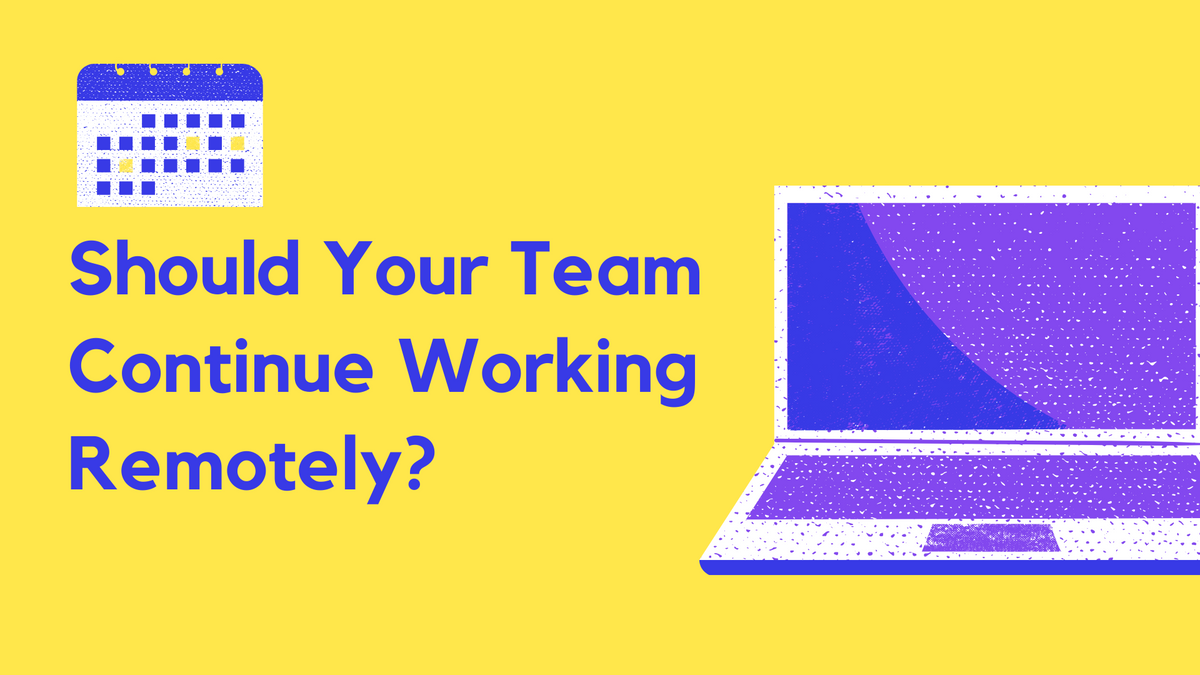From Wall Street to Silicon Valley, companies of all sizes across a variety of industries are at a crossroads. Should they say goodbye to the office forever?
Before we talk about a framework that can help you answer that question, it's important to note that not every company can even ask it. If your business is in manufacturing, food service, hospitality, healthcare, or any other number of vital industries, you and your employees may not have the option to work remotely. In that case, your planning will have to be around how to protect your employees' physical safety and health while they're on the job.
But if your team's pre-pandemic day-to-day experience included commuting to an office building and sitting side-by-side in open floor plans and big conference rooms, you've probably been working remotely for a while now as one of the white-collar companies that the New York Times noted are in a "race to be last to return to the office."
That race makes sense in the short term. No company wants to put their team in jeopardy and risk an office breakout of the coronavirus, which is why companies like Google and Facebook are letting employees stay home until at least next year. But in the medium term and beyond, working remotely indefinitely isn't the only option.
It's a good option, and one that's worked for many companies that make software or provide services that can be done virtually. (PowerToFly is one of those companies—we've been all-remote since the beginning!) Working remotely means saving big on office space, having access to a global talent pool, and optimizing for results versus hours logged, giving employees the freedom to do their work when and from where they're most productive. And all of that can sound really appealing both to employers and to employees.
But working remotely isn't without its pitfalls, including challenges in building company culture (which can affect recruiting and retention) and fostering the right environment for creativity and innovation.
To decide whether your team should continue working remotely, ask these questions:
1. How have your employees been doing during this time?
Objective measurements matter, and we'll get to those in a moment. But managing through this pandemic requires an outsized amount of empathy. Start the process of answering "Should we go back to the office?" by asking the people who would be returning to that office what they think. And actually listen—there's no better source of information about the future of your workforce than that workforce themselves.
You can ask your team for their input through a survey, a meeting, or 1:1 calls. We recommend doing a wide-reaching survey first (which you can make anonymous, if you feel it'll give you better results) and following up with individuals to get more color.
Ask the following questions of your employees to understand what their preferences are about the future:
- How has your productivity been since you've been working from home?
- Have you felt connected to work and to your coworkers while working from home?
- Would you prefer to work from home instead of the office in the future? Why or why not?
- What have been the biggest pain points of working from home? The biggest opportunities?
- Does your enthusiasm about this company or position change over the long-term if we no longer have an office?
- What ideas do you have for how the company's operating model should evolve in the future?
- In your ideal world, how many days a week would you be able to work from home?
2. How has your company been performing during this time?
Now it's time to look at the numbers. Depending on how your company quantifies performance, you may have key performance indicators to look at, progress reports, financial projections, and other data to consider. Gather all of those inputs with your leadership team to review, and consider these key questions:
- Are you meeting key milestones for the development, improvement, or production of your product or offering?
- Can support departments like marketing or HR hit their milestones remotely as well?
- Are your customers or users satisfied? Can they still be serviced effectively by a remote team?
Some KPIs are vital to running a business—including financial ones like monthly revenue or customer acquisition costs—but are less relevant as you strategize the possibility of long-term remote work, since they're currently being greatly affected by the pandemic. Your goal in looking at the data is to understand whether in a normal environment, your company could function well working remotely, using this extended shelter-in-place period as a kind of unplanned experiment.
3. What's practical and safe?
Once you know what your employees want and what your business needs, it's time to overlay a level of practicality on top of your strategy.
Let's look at Austin-based software company Pinpoint as an example of how this could work.
As covered in this Marker story, Pinpoint's lease was set to end this August, and its CEO was planning on more than quadrupling the square footage of their future lease to accommodate his growing company.
But then the pandemic hit and Pinpoint's whole team started working remotely. The CEO surveyed his team and found out that half of his employees wanted to continue working from home. Considering that Pinpoint's main products—programs to help build software better and to better manage the engineers doing so—are remote-work-friendly and slated to fare well in an economic downturn, per Business Insider, Pinpoint's KPIs are probably looking good. (The articles didn't include hard data as to whether that was the case, but let's, for the sake of this example, assume that to be true.)
Now, Pinpoint's CEO is considering a hybrid model: signing a lease for less than half the space he thought he would need in a different, less expensive neighborhood (considering that fewer employees would be regularly commuting); looking for different amenities within that lease (no desks, but instead spaces for collaboration and meetings); and otherwise enabling employees to work from home.
Here are some practical realities to consider:
- Is it safe to return to the office in any capacity? If no, you have your answer for now. Listen to government officials, health organizations, and certain key stats—like whether there has been 14 days of reduced COVID-19 cases in your area—to determine when going back to the office is even an option.
- What are the conditions of your current lease? If you have a multi-year lease, can you get out of it? If not, can you rearrange the space you have to be optimized for a new working model, like by getting rid of cubicle farms and instead investing in socially-distanced hotspots for anyone who does come in?
- What can you do with the money that previously went to your lease? If you decide to get rid of the office entirely and your lease allows you to do it, can you reinvest some of that money in remote-friendly policies, like giving employees a stipend to buy technology or furniture for their home offices or making weeklong retreats a regular thing? Both of those can go a long way in smoothing out some of the bumps of remote work (such as working from an ill-equipped home office or not getting facetime with coworkers), while still helping the bottom line.
Going forward, there's no one right answer.
The future of work might look like remote employees coming together in socially-distanced ways to collaborate or connect. It might look like the complete extinction of office buildings and downtowns. Or it might look much like our pre-COVID reality, just with much more hand sanitizer. (Remember that post-9/11, some prophesied that no one would want to work in a skyscraper again. That didn't last long.)
Right now, all you can do is start gathering information and strategizing about what's right for your company in the long term. We hope the above framework and questions can help.
And if you're interested in learning more about running a remote company, check out the resources below or get in touch with our leadership team—we're happy to share our story.




